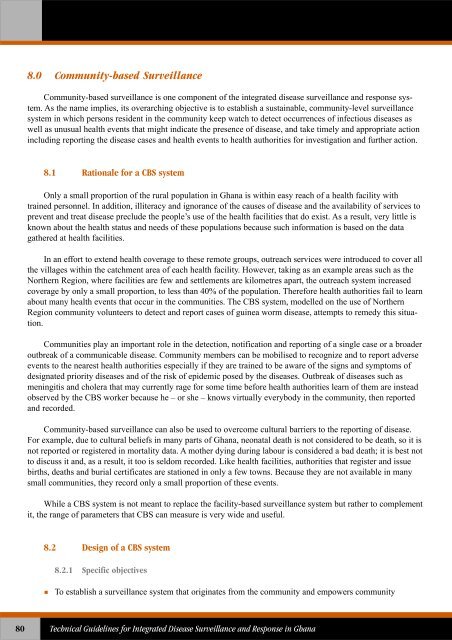Technical Guidelines for Integrated Disease Surveillance ... - PHRplus
Technical Guidelines for Integrated Disease Surveillance ... - PHRplus
Technical Guidelines for Integrated Disease Surveillance ... - PHRplus
You also want an ePaper? Increase the reach of your titles
YUMPU automatically turns print PDFs into web optimized ePapers that Google loves.
8.0 Community-based <strong>Surveillance</strong>Community-based surveillance is one component of the integrated disease surveillance and response system.As the name implies, its overarching objective is to establish a sustainable, community-level surveillancesystem in which persons resident in the community keep watch to detect occurrences of infectious diseases aswell as unusual health events that might indicate the presence of disease, and take timely and appropriate actionincluding reporting the disease cases and health events to health authorities <strong>for</strong> investigation and further action.8.1 Rationale <strong>for</strong> a CBS systemOnly a small proportion of the rural population in Ghana is within easy reach of a health facility withtrained personnel. In addition, illiteracy and ignorance of the causes of disease and the availability of services toprevent and treat disease preclude the people’s use of the health facilities that do exist. As a result, very little isknown about the health status and needs of these populations because such in<strong>for</strong>mation is based on the datagathered at health facilities.In an ef<strong>for</strong>t to extend health coverage to these remote groups, outreach services were introduced to cover allthe villages within the catchment area of each health facility. However, taking as an example areas such as theNorthern Region, where facilities are few and settlements are kilometres apart, the outreach system increasedcoverage by only a small proportion, to less than 40% of the population. There<strong>for</strong>e health authorities fail to learnabout many health events that occur in the communities. The CBS system, modelled on the use of NorthernRegion community volunteers to detect and report cases of guinea worm disease, attempts to remedy this situation.Communities play an important role in the detection, notification and reporting of a single case or a broaderoutbreak of a communicable disease. Community members can be mobilised to recognize and to report adverseevents to the nearest health authorities especially if they are trained to be aware of the signs and symptoms ofdesignated priority diseases and of the risk of epidemic posed by the diseases. Outbreak of diseases such asmeningitis and cholera that may currently rage <strong>for</strong> some time be<strong>for</strong>e health authorities learn of them are insteadobserved by the CBS worker because he – or she – knows virtually everybody in the community, then reportedand recorded.Community-based surveillance can also be used to overcome cultural barriers to the reporting of disease.For example, due to cultural beliefs in many parts of Ghana, neonatal death is not considered to be death, so it isnot reported or registered in mortality data. A mother dying during labour is considered a bad death; it is best notto discuss it and, as a result, it too is seldom recorded. Like health facilities, authorities that register and issuebirths, deaths and burial certificates are stationed in only a few towns. Because they are not available in manysmall communities, they record only a small proportion of these events.While a CBS system is not meant to replace the facility-based surveillance system but rather to complementit, the range of parameters that CBS can measure is very wide and useful.8.2 Design of a CBS system8.2.1 Specific objectives To establish a surveillance system that originates from the community and empowers community80<strong>Technical</strong> <strong>Guidelines</strong> <strong>for</strong> <strong>Integrated</strong> <strong>Disease</strong> <strong>Surveillance</strong> and Response in Ghana















